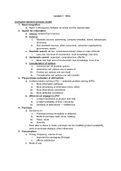Lecture 1 - Intro
Consumer decision process model
1. Need recognition
a. Need: a discrepancy between an actual and the desired state
2. Search for information
a. Internal: retrieval from memory
b. External:
i. Marketer sources: advertising, company websites, stores, salespeople,
brochures
ii. Non-marketer sources: other consumers, consumer organizations,
government, media
c. Heuristic search: ad-hoc, convenience-based, relies on rules of thumb
i. Less risk, low level of involvement, more knowledge, less time
d. Systematic search: organized, comprehensive, effortful
i. More risk, high level of involvement, less knowledge, more time
e. Consideration of options
i. Universal set: all possible options
ii. Awareness set: options one is aware of
iii. Evoked set: options one can recall
iv. Consideration set: options one will consider
3. Pre-purchase evaluation of alternatives
a. Limited problem solving (LPS) → extended problem solving (EPS)
i. More information gathered
ii. More processing of information (time, effort)
iii. More alternatives considered
iv. More attributes considered
b. When do we engage in LPS?
i. Limited importance of product (low-risk)
ii. Limited availability of time / resources
iii. Similarity of alternatives → indifference
4. Purchase
a. Decisions on:
i. Purchase timing (immediate or delayed)
ii. Mode of purchase (web, store, catalog)
iii. Place / store
iv. Quantity
- Even after a choice is made, purchase can be modified (product availability,
point-of-purchase displays, other influences)
5. Consumption
a. Timing, frequency, volume of use
i. Important for packaging (Storage)
ii. Affects satisfaction
b. Mode of use:
, i. Proper use (follow instructions)
ii. Alternate uses (e.g. the pool noodle)
6. Post-consumption evaluation
a. Expectations are crucial
i. Satisfaction: product meets or exceeds expected performance
ii. Dissatisfaction: product performs below expectation
b. 3 sources of consumption
i. Anticipatory consumption
ii. The act of consuming
iii. Enjoying memory of the past consumption
7. Disposal
a. Three ways of disposal
i. Throwing away
ii. Recycling it
iii. Remarketing it (selling
, Lecture 2 - Consumer Memory and Learning
Consumer Decision Process Model
Memory: need recognition → search for information → pre-purchase evaluation of alternatives
→ purchase → consumption → post-consumption evaluation → disposal
Memory system:
Sensory memory: all the information that you encode and use for a moment and throw it away.
But if it is relevant, it goes into working memory/short term memory (this also happens with
rehearsal or attention to certain information)
If the information is not encoded from STM to LTM it will be dropped. In order to retrieve
information from LTM, your brain has to utilize a sort of encryption key to pull that information
back out.
Short term/working memory
- Limited duration
- Limited capacity
- Chunking: are brains chunk information into efficient subsets so it's easier for us
to store those chunks. Chance of transfer to LTM increases when meaning is
added to the chunks.
→ we don’t need short term/working memory as much anymore because of technology.
Long term memory
- Unlimited duration
- Unlimited capacity
- Efficient organization
, → memories that are connected to other things that have meaning are more easily retrieved
then memories that are not connected to anything
→ memory turns from STM to LTM by semantic coding: attaching meaning to a information
How is information stored in LTM?
- Associative network: associations may emerge from personal experience, advertising
cues, other people’s experiences, etc. (the information we've stored in LTM)
- We can map out all the information probably stored about info because it is
systematic
- Node
Properties of associations
Secondary associations: associations of associations
- Tesla → electric car → less gas / lithium mining (= secondary associations)
- Secondary associations are two steps along a associative pathway
-
Reciprocal associations: category evokes a brand; brand evokes a category
- Tesla <-> electric cars
- Cigarettes <-> Marlboro
- When a brand is so central to a brand category, you have a reciprocal association





